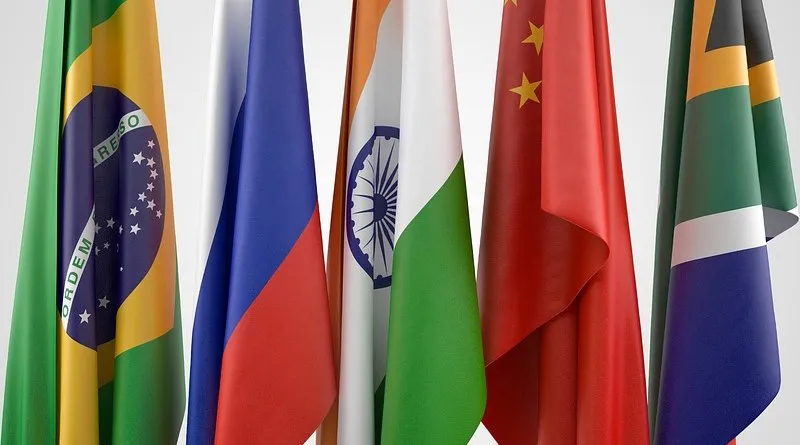
When the BRICS was initiated, it was an organisation meant to express a new geopolitical will as against the Western geopolitical order. Meanwhile, it has become expression of hopes and desires for economic development, progress, representation in international fora and the need to contribute and play a role in defining the global agenda and finding solutions to global issues.
BRICS reunites five countries: Brazil, Russia, India, China, and South Africa. The “BRIC” concept was created in 2001 by the Goldman Sachs economist Jim O’Neill, and the “S” was added after South Africa joined the group in 2010.
Between August 22nd – 24th, 2023, South Africa will host the 15th BRICS Summit at the Sandton Convention Centre in Johannesburg.
More countries have become interested in joining the group: Afghanistan, Algeria, Argentina, Bahrain, Bangladesh, Belarus, Egypt, Indonesia, Iran, Kazakhstan, Mexico, Nicaragua, Nigeria, Pakistan, Saudi Arabia, Senegal, Sudan, Syria, United Arab Emirates, Thailand, Tunisia, Turkye, Uruguay, Venezuela, Zimbabwe. This growing interest for the BRICS project has various underlying motivations, which have to be accommodated within the broader framework.
Liviu Muresan, president of Eurodefense Romania, has shared the assessment made by this international think-tank during their latest meeting, and we can understand why some countries are attracted by these new structures:
“The challenging international security environment, with the war in Ukraine for over 500 days, with no clear perspective yet for a negotiated peace… The United States – China relations see an attempt for rebuilding mutual trust made by the high US officials who visit China…An evolving multipolar world, opening the door for new relations and new organisations which are coming into being or already operational. Networks such as BRICS, the Shanghai Cooperation Organisation (SCO), the Belt and Road Initiative attract enhanced cooperation with the Eurasian Economic Union, ASEAN a.s.o. Several of these countries have experienced both economic and demographic growth and they feel under-represented in the traditional international organisations. China and Russia have been subject to international sanctions that turned out to be totally inefficient…”
That BRICS has the potential of becoming a global player is a fact, since more countries intend to join the group, and if we look carefully, each of them has significant assets to contribute: some have huge financial potential, others have huge demographic potential, others have expertise in particular industries.
“One of the objectives at the Johannesburg Summit”, says Liviu Muresan, “will be to agree on a new payment instrument, meant to reduce the role of the USD in international exchanges, with the aim of eventually replacing it. However, the interests of the current members and those of possible future members have to be harmonized. India, currently at the presidency of SCO and G20, has revealed its own agenda, which seems to be no longer in line with that of other BRICS countries, mainly China. For instance, at the latest SCO Summit that took place in India, the host country refused to sign the final declaration of support to the BRI project. Beyond occasional mutual disagreement, the potential of the BRICS countries is obvious. Topics on the Summit’s Agenda include: infrastructure, innovation, improvements to the urban environment, nuclear technologies for African development, independent systems for assessing and promoting national science programmes, so BRICS is consolidating its position as a competitor to G7, while the US and the EU find it more and more difficult to control economic development on a global scale and to impose Western values.”
For China, this summit will be a new opportunity to present its current projects, as well as its new initiatives, such as GDI (Global Development Initiative), GSI (Global Security Initiative), GCI (Global Civilisation Initiative). The already ten-year old Belt-and-Road Initiative (BRI) currently covers 147 countries with more than 3,000 projects worth trillions of USD.
To counter the BRI, in 2021, the US initiated the Build Back Better World (B3W) plan of 40 trillion USD and the EU initiated its Global Gateway plan of 340 billion USD. Moreover, in May 2022, during Biden’s visit to Japan, the U.S. initiated the Indo-Pacific Economic Framework for Prosperity (IPEF), including 13 countries, an alternative to China’s Regional Comprehensive Economic Partnership (RCEP), launched in November 2020 and including 15 countries. While the plans have the declared goal of promoting a transparent infrastructure funding paradigm to counter the “predatory” Chinese projects, it is not yet very clear what, where and how they build.
Meanwhile, despite its ups and downs, China’s Belt-and-Road Initiative (BRI) can showcase its facts and figures. As an example, only in Africa, 100,000 km of railways, hundreds of power plants, schools, hospitals, have been built under the BRI umbrella, which improved tremendously connectivity and people’s lives. The latest report of CMS Africa, an independent UK organisation, begins with two key points: “Sentiment towards BRI is relatively positive in Africa, with a majority of African respondents wanting to increase their involvement in BRI projects, and while a small majority of African respondents have found involvement in BRI projects more challenging than expected, a majority have also been satisfied with the outcome of their involvement.”
Beyond occasional mutual antagonistic manifestations among the BRICS members, after all, countries want prosperity, security and protection, and that’s why they join alliances. That’s why a list of countries are now contemplating whether “TO BRICS or NOT TO BRICS”.
